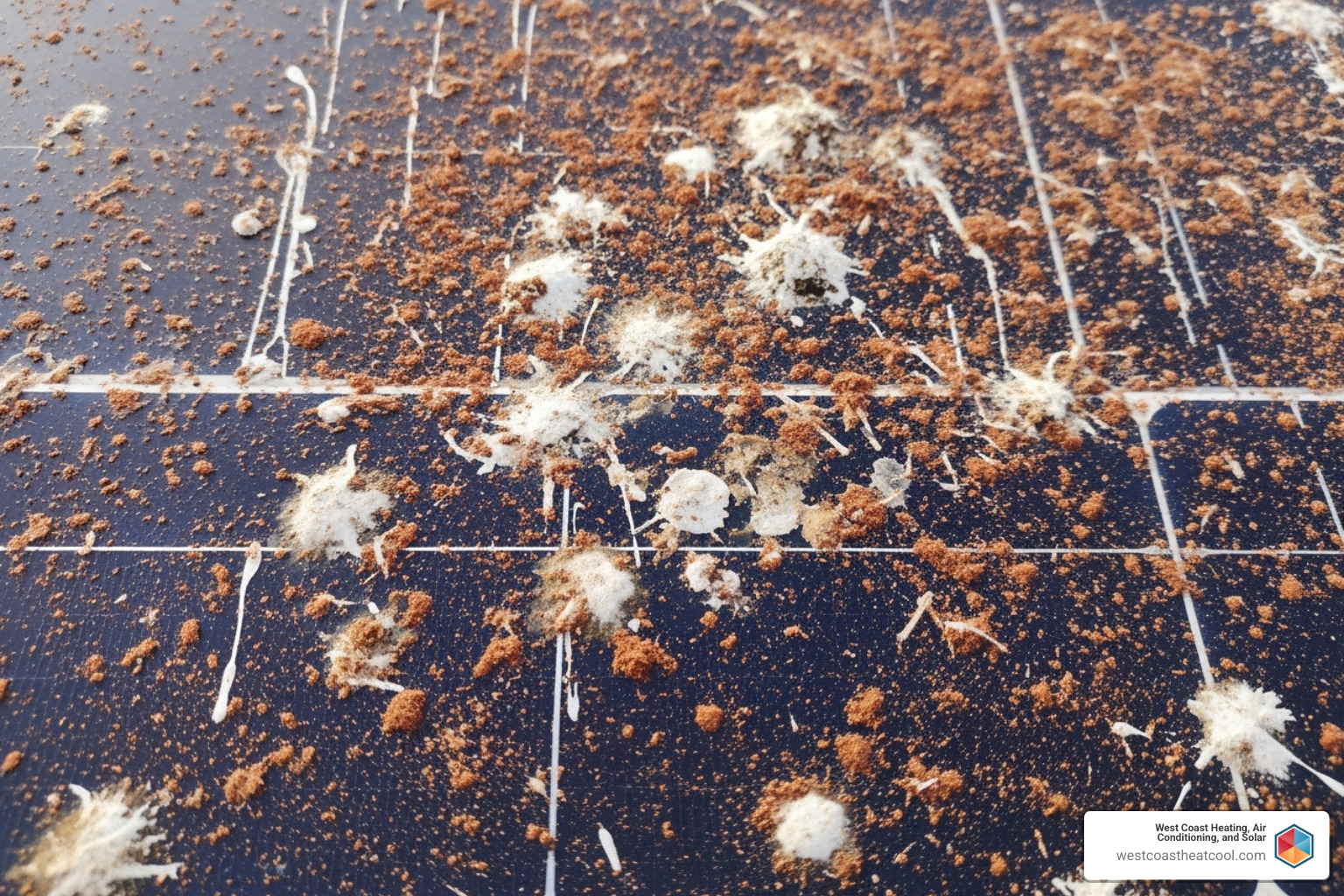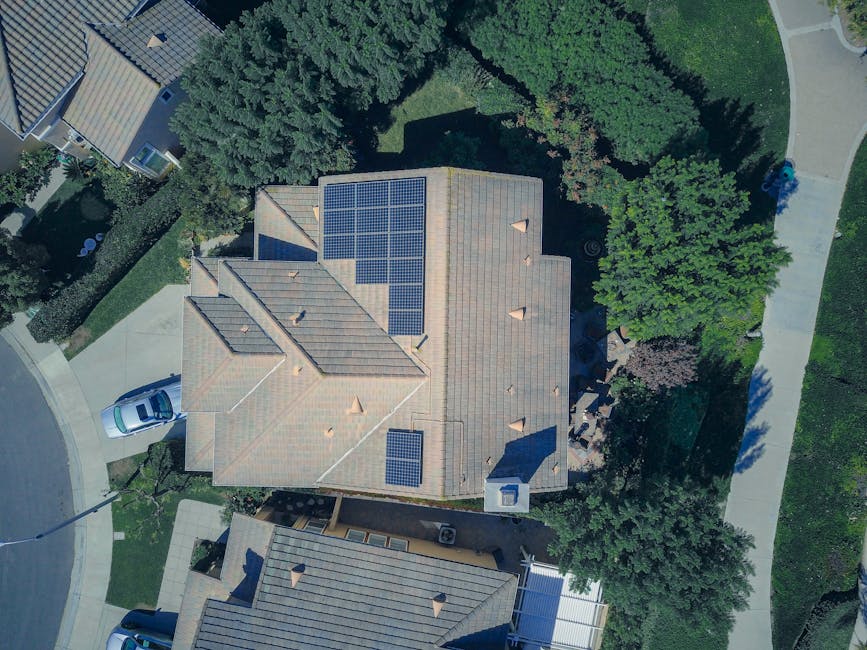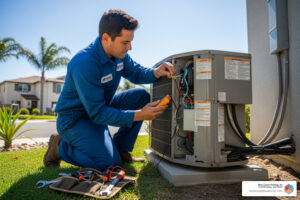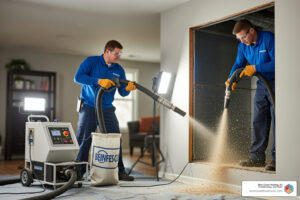Why Solar Panel Cleanliness Matters for Your Investment
Does cleaning solar panels make a difference? Yes, cleaning can improve solar panel efficiency, but the impact varies significantly based on your location, panel angle, and local environmental conditions. Here’s what the research shows:
Quick Answer:
- Clean panels perform better – removing dirt, dust, and debris allows more sunlight to reach solar cells
- Efficiency gains range widely – from 1% improvement in some studies to 25% in heavily soiled conditions
- Location matters most – dry, dusty areas see bigger benefits than regions with frequent rain
- Flat panels need more cleaning – angled panels (common in San Diego) self-clean better with rain and wind
- Cost-benefit varies – professional cleaning ($150-300) may not always pay for itself in energy savings
Your solar panels are a significant investment in your home’s energy future. Like any investment, you want to maximize their performance and protect their value. But with conflicting information everywhere – from studies showing minimal 1% improvements to others claiming 50% efficiency losses – it’s hard to know what’s actually true for your San Diego home.
The reality is more nuanced than simple yes-or-no answers. Multiple factors determine whether cleaning makes a meaningful difference: your panel’s tilt angle, San Diego’s unique climate conditions, the type of debris accumulating on your system, and whether the cost of cleaning outweighs the energy gains.
In this guide, we’ll cut through the confusion with real data, practical advice, and specific recommendations for San Diego homeowners. You’ll learn exactly when cleaning pays off and when you can skip it without worry.
The Great Debate: How Much Energy Do Dirty Solar Panels Really Lose?
The question of does cleaning solar panels make a difference in energy output often sparks a lively debate. On one hand, it seems intuitive that anything blocking the sun would reduce efficiency. On the other, some studies suggest the impact is minimal. So, what’s the real story?
Solar panels generate electricity by converting sunlight into energy. When dirt, dust, pollen, bird droppings, or other debris accumulate on the surface, they create a barrier that prevents sunlight from reaching the photovoltaic (PV) cells. This blockage, known as soiling, directly impacts your system’s energy output and, consequently, your energy savings.
The Surprising Numbers: From Negligible to Significant Losses
Research on how much energy is lost due to dirty solar panels presents a wide range of figures, often leading to confusion. Why the discrepancy? It largely depends on the specific conditions of the study, including location, climate, and the type and severity of dirt.
Consider these findings:
- Minimal Impact: A study from UC San Diego found that panels uncleaned for 145 days during a summer drought in California lost only 7.4 percent of their efficiency. On average, these panels lost a little less than 0.05 percent of their overall efficiency per day. For a typical 5kW residential system, washing panels halfway through summer might only translate into a $20 gain in electricity production. This led engineers to conclude that, for many residential systems, cleaning is often not worth the cost. Similarly, an Australian study concluded that the impact of uncleaned panels on solar output was in the order of 1%, and therefore negligible.
- Moderate to Significant Impact: The National Renewable Energy Laboratory (NREL) puts the potential efficiency loss from dirt even higher, at up to 25%. The Solar Energy Power Association also states that dirty solar panels can reduce power-generating output by 20% or more. In certain areas of the U.S., the energy lost from soiling each year is as high as 7%.
- Dramatic Impact: In more extreme cases, the numbers jump significantly. Recent university research has shown that a dirty solar panel can lose 50% of its efficiency compared to a clean solar panel. One compelling example comes from a Google study, which found that output improved by 100% after cleaning their panels for the first time in 15 months – these panels were installed flat with no tilt. A second clean eight months later improved output by 36%. Another real-world case saw dirty panels producing 744 kWh increase to 910 kWh after cleaning, a 21% increase in electricity production.
So, while some studies show minimal loss, others demonstrate a substantial drop in efficiency. The key is understanding what factors contribute to these varying outcomes.
Key Factors That Determine the Impact of Dirt
The impact of dirt on your solar panels isn’t a one-size-fits-all scenario. Several factors play a crucial role in how much efficiency you might lose and, consequently, how much cleaning solar panels makes a difference for your system.
- Panel Tilt Angle: This is perhaps one of the most critical factors. Solar panels installed at a steeper angle (typically 10 degrees or more) benefit significantly from natural cleaning. Rain and wind can more easily wash away dust and debris from tilted surfaces. The Google study, for instance, concluded that while flat panels showed huge improvements, the improvement in output from cleaning their rooftop panels installed on an angle was negligible. Panels mounted at an angle of less than five degrees cause bigger losses in efficiency because dirt slips off panels installed at a steeper angle more easily.
- Geographic Location: Your local climate and environment are huge determinants.
- San Diego Climate: Our beautiful San Diego County experiences dry periods, especially during summer droughts, which can lead to dust accumulation. However, we also get rain, which helps. Coastal areas might experience salt spray buildup, which can be harder for rain to wash away effectively.
- Dry, Dusty Areas: Locations with minimal rainfall, like deserts, or those near agricultural fields, construction sites, or busy highways, will naturally accumulate more dust and particulate matter. In these environments, cleaning makes a much more significant difference.
- Pollution: Areas with high levels of air pollution (smog, industrial emissions) can lead to a sticky grime that’s difficult for rain alone to remove.
- Specific Debris: Not all dirt is created equal.
- Bird Droppings: These are notorious for causing significant localized shading and are very difficult for rain to wash away. A single bird dropping can block a substantial portion of a solar cell, drastically reducing its output.
- Wildfire Ash: Unfortunately, a reality for many in California, ash fallout from wildfires can reduce power production by as much as 50% or more. Ash is particularly problematic because it’s fine, sticky, and can create a thick layer that rain struggles to penetrate. A system in hazy conditions from wildfire smoke produced 19% less energy per day compared to clear conditions.
- Pollen: During allergy season, a thick layer of pollen can settle on panels, reducing efficiency.
- Oily Stains: If you live near a common truck route or an airport, you might find oily stains on your panels that require more than just water to remove.
Understanding these factors helps us determine when cleaning is truly beneficial for your system.
Does Cleaning Solar Panels Make a Difference to Your Wallet? A Cost-Benefit Analysis
Let’s get to the heart of what really matters for most homeowners: does cleaning solar panels make a difference to your monthly budget? After all, improved efficiency means nothing if the cleaning costs more than the energy savings you’ll see.
The math here can be surprisingly eye-opening, and not always in the way you might expect.
Calculating the Cost vs. the Reward
Here’s where things get interesting. Professional solar panel cleaning typically runs between $90 to $300 for most residential systems, with the national average sitting around $133. For larger systems, you might pay $15-$30 per panel. So if you have a standard 6.6kW system with about 20 panels, you’re looking at $180-$360 for professional cleaning.
Now, UC San Diego study we mentioned earlier? They found that cleaning a 5kW system after 145 days of drought conditions only resulted in about $20 worth of additional energy production. When you compare that $20 gain to a $150-$300 cleaning bill, the numbers simply don’t add up.
But hold on – it’s not that simple across the board.
The financial benefits become much more compelling when your panels are heavily soiled. Real-world example from Templeton, California, where cleaning boosted production by 21%? That translated to $37 more energy per month, or about $440 annually. Suddenly, that $200 cleaning service looks like a smart investment.
Flat or low-tilt panels also change the equation entirely. Google’s famous study showed their flat panels improved by 100% after their first cleaning in 15 months. Even if your panels aren’t quite that dirty, improvements of 25-30% aren’t uncommon for flat installations – easily justifying the cleaning cost.
Your local electricity rates matter too. If you’re paying premium rates for power, even modest efficiency gains translate to meaningful dollar savings. You can estimate your potential lost revenue using this simple formula: (Total kWh Produced Monthly) x (30 days x 0.0005) x (Your Price per kWh).
For most angled residential systems in San Diego, experts suggest you’d need to see production improvements of 25-30% to offset professional cleaning costs. That’s a pretty high bar, which is why we always recommend monitoring your system’s performance before scheduling a cleaning.
Does cleaning solar panels make a difference for your warranty?
This question keeps many homeowners up at night, and rightfully so. The good news? Most solar warranties don’t require regular cleaning. Manufacturers design these systems to handle outdoor life with minimal fuss.
However, there’s an important “but” here.
While cleaning isn’t typically required, how you clean matters enormously for your warranty protection. Using harsh chemicals, abrasive scrubbers, pressure washers, or attempting to clean hot panels can cause real damage. Scratches, cracks, or seal problems from improper cleaning could absolutely void your warranty coverage for that specific damage.
Most manufacturers do provide recommended cleaning guidelines in their documentation. Following these guidelines isn’t just smart – it’s your best protection if you ever need to make a warranty claim.
Keeping records of any professional cleaning services or your DIY maintenance efforts is also wise. If you face unexpected performance issues down the road, showing that you’ve properly maintained your system strengthens your warranty position.
At West Coast Heating, Air Conditioning, and Solar, we always tell our customers to check their specific warranty documents for any unique maintenance clauses. Every manufacturer is slightly different, and when you’re protecting a significant investment, it pays to know exactly where you stand. If you’re ever unsure, give us a call – we’re happy to help you understand your warranty requirements and keep your system performing at its best.
The Right Way to Clean: A Guide to Safe and Effective Solar Panel Maintenance
So, if you’ve decided that cleaning solar panels does make a difference for your specific situation, the next step is to know how to do it safely and effectively. There are two main approaches: DIY cleaning or hiring professionals.
DIY Solar Panel Cleaning: Tools and Techniques
If your panels are easily accessible and you feel comfortable working on a ladder (if needed), DIY cleaning can be a cost-effective option for light to moderate soiling. The good news? You probably already have most of what you need at home.
Safety comes first, always. Before you even think about touching those panels, you need to turn off your entire solar system. This isn’t optional – it’s critical for preventing electrical hazards. Check your system manual or call your installer if you’re not sure how to do this properly.
Timing matters too. Clean your panels early morning or early evening when they’re cool to the touch. Here’s why: spraying cold water on hot panels can cause thermal shock, potentially cracking the glass. Nobody wants a cracked solar panel, trust me.
Here’s what you’ll need: A soft-bristle brush with an extension pole long enough to reach your panels safely from the ground, a standard garden hose (never a pressure washer!), mild biodegradable soap like regular dish soap, a squeegee with a soft blade, and clean, lukewarm water.
Start by giving your panels a thorough rinse with the garden hose. This removes loose dirt and debris, preventing scratches when you start scrubbing. Mix some mild soap with clean water in a bucket, then gently apply it with your soft brush or cloth, working in sections.
When scrubbing away stubborn bird droppings or grime, be gentle. These panels are tough, but they’re not indestructible. Rinse everything thoroughly with clean water – soap residue left behind will just attract more dirt. Finish with the squeegee for that streak-free shine.
What NOT to do: Never use pressure washers (too powerful), harsh chemicals like bleach or ammonia (they’ll damage the coatings), abrasive scrubbers or steel wool (scratches galore), and absolutely never walk on your panels. That last one bears repeating – never walk on solar panels. It’s dangerous and can shatter them completely.
When to Call the Professionals
While DIY cleaning works for some situations, there are plenty of times when calling the experts is the smarter move. And honestly, sometimes it’s just easier to let someone else handle the dirty work while you enjoy your weekend.
Safety should always be your top priority. If your panels are on a steep roof, a two-story home, or anywhere that makes you think “hmm, this looks sketchy,” please don’t attempt it yourself. Professional technicians have proper safety equipment like harnesses, ropes, and stable ladders, plus the training to use them correctly.
Some grime just won’t budge with a gentle scrub and garden hose. Persistent bird droppings, oily stains from nearby traffic, or heavy ash buildup from wildfires need specialized cleaning solutions and equipment. Professionals have access to deionized water systems and commercial-grade cleaners that can tackle these stubborn problems without damaging your panels.
Here’s a bonus you don’t get with DIY: system inspection. When our technicians clean your panels, they’re not just scrubbing away dirt. They’re also checking for signs of damage, loose wiring, or potential issues that might affect performance. It’s like getting a mini health checkup for your solar system.
Professional cleaning typically runs between $100 to $300, but the peace of mind, safety, and thoroughness often make it worthwhile – especially for complex installations or heavily soiled systems. Plus, you get to spend your Saturday doing something more fun than climbing around on your roof.
If you’re dealing with safety concerns, stubborn grime, or just want the confidence that comes with professional service, our solar panel maintenance services are designed specifically for San Diego homeowners who want to protect their solar investment.
Frequently Asked Questions About Solar Panel Cleaning
Living in San Diego County, from the coastal breeze of Carlsbad to the inland warmth of Chula Vista, we get these questions about solar panel cleaning almost daily. Let’s explore the answers that matter most to you.
How often should I clean my solar panels?
Here’s the truth: there’s no magic number that works for everyone. Does cleaning solar panels make a difference in how often you should clean them? Absolutely, but it depends entirely on your unique situation.
Most homeowners do well with cleaning twice a year – think of it like changing your air conditioning filters. But your San Diego location can change this timeline dramatically.
If you live near dusty construction sites or agricultural fields, you might notice buildup every few months. Coastal homeowners often deal with salt spray that creates a stubborn film rain can’t wash away. And let’s be honest – during pollen season, your panels can look like they’ve been dusted with yellow powder overnight.
The best approach? Let your system tell you. Most modern solar installations come with monitoring apps that track energy production. If you notice your output dropping consistently and it’s not due to cloudy weather or new shade from that tree you planted, dirty panels might be the culprit.
Sometimes the simplest method works best: just look up at your panels. If they’re visibly grimy, covered in bird droppings, or have that telltale layer of dust, it’s probably time for a cleaning.
During San Diego’s dry seasons, you might need more frequent attention. After a good rain, especially on angled panels, you can often wait longer between cleanings.
Is rain enough to clean solar panels?
We wish it were that simple! Rain is like having a helpful assistant – it does some of the work, but it can’t handle the tough jobs.
Rain works great for loose dust and pollen, especially on panels with a decent tilt. Mother Nature’s rinse cycle can keep lightly soiled panels reasonably clean between manual cleanings.
But here’s where rain falls short: it can’t tackle the sticky stuff. Bird droppings, tree sap, and that oily residue from traffic pollution laugh at rainwater. These stubborn contaminants need the gentle scrubbing action that only proper cleaning can provide.
Rain can even create new problems. As rainwater evaporates, it leaves behind dissolved minerals and dust particles, creating water spots or a thin film on your panels. It’s the same reason your shower door gets cloudy even though water hits it every day.
Research shows that professionally cleaned panels can produce 12% more energy compared to panels cleaned only by rain. That’s real money staying in your pocket instead of going to the utility company.
Think of rain as regular maintenance, but not a complete solution. It’s like washing your car – a rainstorm might rinse off surface dirt, but you still need soap and elbow grease for a truly clean finish.
Can I damage my solar panels by cleaning them?
Unfortunately, yes – and this is where many well-meaning homeowners get into trouble. Cleaning solar panels does make a difference, but improper cleaning can turn a money-saving maintenance task into an expensive repair bill.
Thermal shock is the biggest risk most people don’t think about. Spraying cold water on hot panels can crack the glass faster than you can say “oops.” Always clean when panels are cool – early morning or evening is perfect.
Scratches are another common problem. Even soft-looking brushes can pick up grit and scratch the anti-reflective coating or glass surface. These scratches block sunlight just like dirt does, defeating the whole purpose of cleaning.
Chemical damage happens more often than you’d think. That bottle of Windex might seem perfect for glass, but ammonia-based cleaners can strip protective coatings and corrode panel frames. Stick to mild dish soap – it’s gentler and just as effective.
Pressure washers are tempting because they seem so efficient, but they’re like using a sledgehammer to hang a picture. The high-pressure water can force moisture into seals, crack glass, or damage electrical connections.
And please, never walk on your panels. They’re designed to handle weather, not people. Even a single footstep can cause invisible micro-cracks that reduce efficiency or lead to complete panel failure.
The electrical risk is real too. Water and electricity don’t mix, so always shut down your system before cleaning.
When in doubt, call us at West Coast Heating, Air Conditioning, and Solar. We’ve seen too many expensive mistakes that could have been avoided with professional cleaning from the start.
The Verdict: Should You Clean Your San Diego Solar Panels?
After sifting through all the research, crunching the numbers, and exploring the best cleaning methods, what’s our final answer to does cleaning solar panels make a difference for your San Diego home?
Final thoughts on whether cleaning solar panels makes a difference
Here’s the honest truth: there’s no one-size-fits-all answer. Does cleaning solar panels make a difference? It absolutely can – but whether it makes sense for your specific situation depends on several key factors.
Think of it like washing your car. If you park under trees where birds love to perch, you’ll need to wash it more often than someone who parks in a covered garage. Your solar panels work the same way.
For most San Diego homeowners with angled panels, Mother Nature does a pretty decent job. Our occasional rains, combined with panels tilted at 10 degrees or more, naturally wash away most dust and pollen. In these cases, you might only see efficiency improvements of 1-7%, which often doesn’t justify the $150-300 cost of professional cleaning.
But here’s where it gets interesting. If your panels are dealing with stubborn bird droppings, wildfire ash, or you live near a dusty construction site, cleaning can boost your energy production by 20-50%. That’s real money back in your pocket – potentially hundreds of dollars annually.
Location within San Diego County matters too. Coastal homes deal with salt spray buildup, while inland areas might face more dust and pollen. If you’re in Chula Vista near agricultural areas or Carlsbad by the coast, your cleaning needs will be different than someone in the central valley.
The smartest approach? Monitor your system’s performance. Most modern solar systems come with apps that show daily production. If you notice a consistent drop that isn’t explained by cloudy weather or new shade from a neighbor’s tree, it’s time to investigate.
Safety should always be your top priority. If your panels are on a steep roof or second story, please don’t risk a dangerous DIY trip. The potential savings aren’t worth a trip to the emergency room.
At West Coast Heating, Air Conditioning, and Solar, we’ve been helping San Diego families maximize their energy efficiency since 1996. We understand that every home is unique, and we’re here to help you figure out what works best for your specific situation.
Whether you need a professional assessment, safe cleaning services, or just want to chat about your system’s performance, we’re your local solar experts. After all, we want you to get every bit of value from your solar investment while keeping your family safe.
Schedule your professional solar panel cleaning in San Diego










